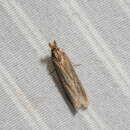zh-TW
在導航的名稱


Anerastia lotella is a species of snout moth in the genus Anerastia. It was described by Jacob Hübner in 1813.[1] It is found in most of Europe,[2] western Russia, Asia Minor, Iran and western Turkestan.[3] It has also been recorded from most of Canada.[4]
The wingspan is 19–27 mm. Adults are on wing in July.[5]
The larvae feed on various Poaceae species, including Ammophila arenaria, Corynephorus canescens and Festuca ovina. They construct a silken gallery around the stem base and roots of their host plant. Larvae are mainly found in May and June and it is thought the species overwinters in the larval stage.[6] Pupation takes place in a silken cocoon in the soil near the food plant.
Anerastia lotella is a species of snout moth in the genus Anerastia. It was described by Jacob Hübner in 1813. It is found in most of Europe, western Russia, Asia Minor, Iran and western Turkestan. It has also been recorded from most of Canada.
The wingspan is 19–27 mm. Adults are on wing in July.
 Figs.4larva after final moult 4a, 4b, 4c, 4d, 4e larval cases and cocoons
Figs.4larva after final moult 4a, 4b, 4c, 4d, 4e larval cases and cocoons The larvae feed on various Poaceae species, including Ammophila arenaria, Corynephorus canescens and Festuca ovina. They construct a silken gallery around the stem base and roots of their host plant. Larvae are mainly found in May and June and it is thought the species overwinters in the larval stage. Pupation takes place in a silken cocoon in the soil near the food plant.
De helmgrasmot (Anerastia lotella) is een vlinder uit de familie snuitmotten (Pyralidae). De wetenschappelijke naam is voor het eerst geldig gepubliceerd in 1813 door Hübner.
De soort komt voor in Europa.
Bronnen, noten en/of referentiesAnerastia lotella é uma espécie de insetos lepidópteros, mais especificamente de traças, pertencente à família Pyralidae.[1]
A autoridade científica da espécie é Hübner, tendo sido descrita no ano de 1813.
Trata-se de uma espécie presente no território português.
Anerastia lotella é uma espécie de insetos lepidópteros, mais especificamente de traças, pertencente à família Pyralidae.
A autoridade científica da espécie é Hübner, tendo sido descrita no ano de 1813.
Trata-se de uma espécie presente no território português.